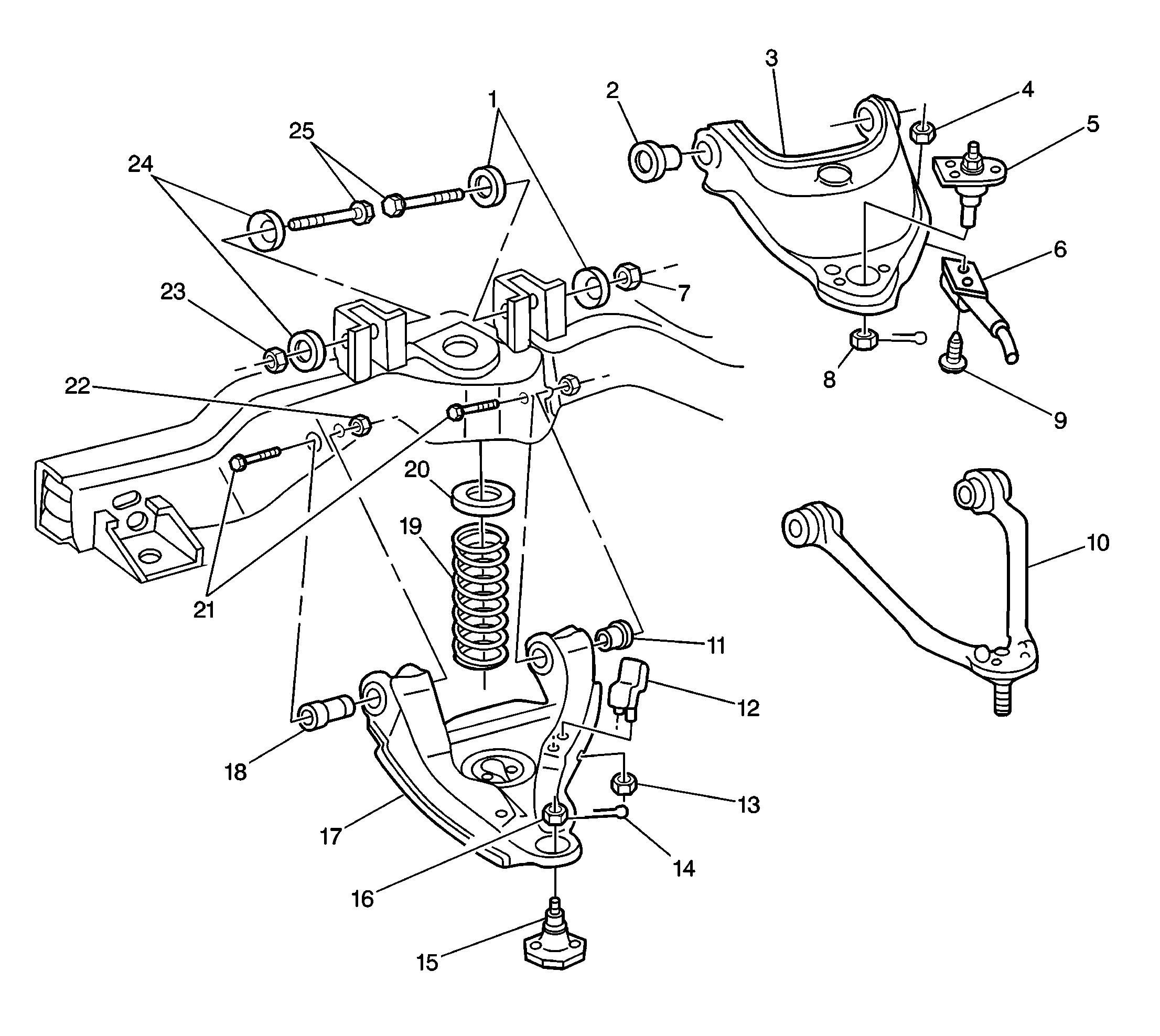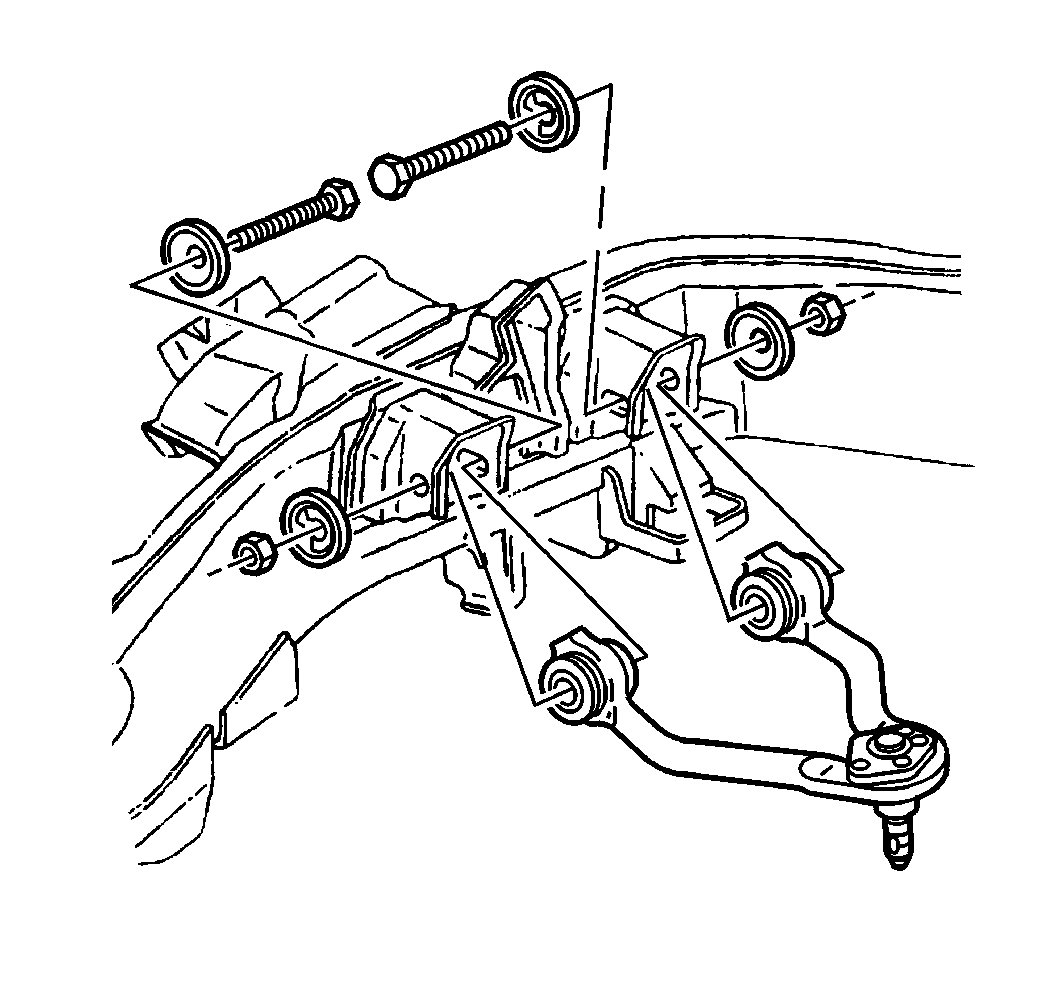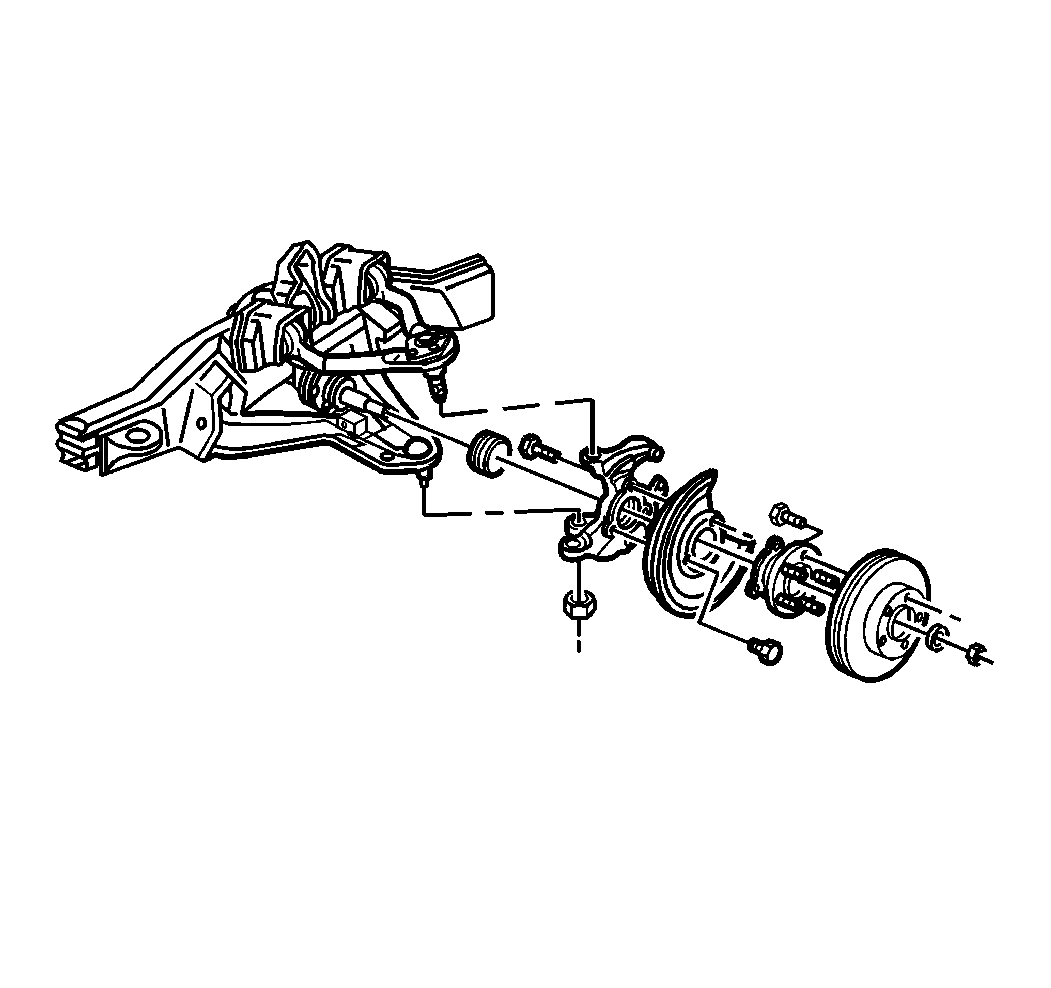Upper Control Arm Replacement 2WD
Removal Procedure
For control arms and components, refer to
Control Arm and Components (2WD)

Caution: Floor jack must remain under the lower control arm during
removal and installation to retain the lower control arm in position. Failure
to do so could result in personal injury.
- Raise the front of the vehicle.
| • | Support the lower control arm with floor stands. |
| • | Because the weight of the vehicle is used to relieve the spring
tension on the upper control arm, position the floor stands between the spring
seats and the ball joints of the lower control arms in order to maintain
maximum leverage. |
- Remove the tire and wheel assembly. Refer to
Tire and Wheel Removal and Installation
in Tires and Wheels.
- Remove the air cleaner extension, if necessary.
- Remove the brake hose bracket from the upper control arm.
| 4.1. | Remove the nuts and the screws. |
| 4.2. | Tie the hose out of the way. |
- Remove the upper ball joint from the steering knuckle. Refer to
Steering Knuckle Replacement
.
- Remove the attaching bolts and nuts of the upper control arm.
- Remove the upper control arm.
- Remove the bushings.
- Inspect all of the parts for wear and damage.
Installation Procedure
- Install the bushings.
- Install the upper control arm to the frame.
Notice: Use the correct fastener in the correct location. Replacement fasteners
must be the correct part number for that application. Fasteners requiring
replacement or fasteners requiring the use of thread locking compound or sealant
are identified in the service procedure. Do not use paints, lubricants, or
corrosion inhibitors on fasteners or fastener joint surfaces unless specified.
These coatings affect fastener torque and joint clamping force and may damage
the fastener. Use the correct tightening sequence and specifications when
installing fasteners in order to avoid damage to parts and systems.
Important:
| • | The pivot bolts must be installed in the proper direction. |
| • | Tighten the front nut prior to tightening the rear nut. |
| • | Tighten the nuts with the control arm at Z height. Refer to
Trim Height Inspection
in Suspension General Diagnosis. |
- Install the bolts and new nuts.
Tighten
Tighten the nuts to 190 N·m (140 lb ft).
- Install the upper ball joint to the steering knuckle. Refer to
Upper Control Arm Ball Joint Replacement
.
- Install the brake hose bracket to the upper control arm.
- Install the bracket screws and the nuts.
Tighten
Tighten the nuts to 18 N·m (13 lb ft).
- Install the brake hose to the bracket.
- Install the air cleaner extension, if necessary.
- Install the tire and wheel assembly. Refer to
Tire and Wheel Removal and Installation
in
Tires and Wheels.
- Check the front wheel alignment. Refer to
Wheel Alignment Measurement
in Wheel Alignment.
Upper Control Arm Replacement 4WD
Removal Procedure
- Raise the vehicle. Support the vehicle with suitable safety stands.
- Remove the tire and wheel assembly. Refer to
Tire and Wheel Removal and Installation
in Tires and Wheels.
- Remove the air cleaner extension, if necessary.
- Remove the brake hose.
| 4.1. | Remove the nut and the screw. |
| 4.2. | Remove the bracket and the hose. |
| 4.3. | Tie the hose out of the way. |
- Remove the cotter pin.
- Remove the nut.
- Disconnect the upper control arm from the knuckle.
- Remove the nuts.

- Remove the bolts.
- Remove the upper control arm.
- Remove the bushings.
Installation Procedure

- Install the bushings.
- Install the upper control arm to the frame.

- Install the bolts and
the washers. Make sure the bolt heads are opposed inside the bracket.
Notice: Use the correct fastener in the correct location. Replacement fasteners
must be the correct part number for that application. Fasteners requiring
replacement or fasteners requiring the use of thread locking compound or sealant
are identified in the service procedure. Do not use paints, lubricants, or
corrosion inhibitors on fasteners or fastener joint surfaces unless specified.
These coatings affect fastener torque and joint clamping force and may damage
the fastener. Use the correct tightening sequence and specifications when
installing fasteners in order to avoid damage to parts and systems.
Important: Tighten the front nut prior to tightening the rear nut.
Tighten the nuts with the control arm at Z height. Refer to
Trim Height Inspection
in Suspension General
Diagnosis.
- Install the new nuts.
Tighten
Tighten the nuts to 190 N·m (140 lb ft).

- Install the upper ball
joint stud to the knuckle.
- Install the nut to the upper ball joint stud.
Tighten
| • | Tighten the nut to 100 N·m (94 lb ft). |
| • | Tighten the nut in order to align the cotter pin. Do not tighten
more than 1/6 turn. |
- Install the new cotter pin. Bend the pin ends against the nut
flats.
- Remove the support from the knuckle.
- Install the brake hose.
| 9.1. | Install the bracket and the hose. |
| 9.2. | Install the screw and the nut. |
- Install the air cleaner extension, if necessary.
- Install the tire and wheel assembly. Refer to
Tire and Wheel Removal and Installation
in Tires and Wheels.
- Lower the vehicle.





